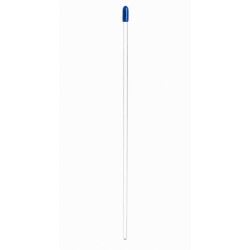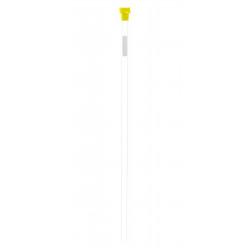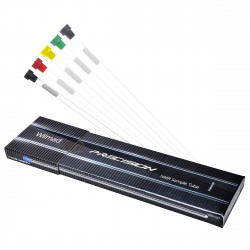
The purpose of an NMR tube is to confine a liquid sample in a perfectly cylindrical volume in a magnetic field. Since this description is based on mechanics, it is not surprising that NMR tubes have been described by structural parameters for many years. The degree to which an NMR sample tube approaches the ideal ‘perfect cylinder’ defines the quality of the NMR tube. But since words like ‘Camber’ and ‘Concentricity’ aren’t associated by spectroscopists with familiar NMR performance criteria like ‘Sensitivity’ and ‘Resolution,’ it is helpful for those who use NMR tubes to understand how the structural specifications published by Wilmad- Labglass relate to NMR instrument performance.

Important terms to know when selecting NMR tubes
Outside Diameter (OD) and Inside Diameter (ID)
A measure of the distance across the center of the tube from the outermost surfaces (for OD) and innermost surfaces (for ID), diameters are measured over a large number of points along the length and around the circumference of the tube. Meeting stringent standards for OD and ID assures the sample tube defines a precisely reproducible cylindrical volume for the sample within the Rf coil. Diameters vary for Wilmad- Labglass NMR tubes over a range that is usually <0.001” (0.026 mm).
Failure to adhere to strict diameter tolerances can produce a diversity of undesirable performance characteristics in NMR spectroscopy. If the ID is too large, vortex plugs and coaxial inserts can move during spectral accumulation. If the ID is too small, finned vortex plugs might actually burst the tube, making sample loss, possibly inside the probe, a catastrophic possibility. When the OD is too small, the tube might slip in the spinner turbine. This can cause spinning wobble, a major source of modulation sidebands. Even more troubling, the sample may shift in the probe or fall completely through the probe when pneumatically lowered into the magnet. In combination with other imperfections in an NMR tube, a tube with an OD that is too large could make contact with the probe insert, damaging the probe - a costly repair!
When the failure to meet OD or ID tolerances is localized in a small area of the tube, portions of the sample might fall outside the ‘perfect’ cylindrical volume and be exposed to a portion of the magnetic field which may not be homogeneous with the remaining portions of the sample within the ‘perfect’ cylinder. You’ll know this is the case if you must perform extensive shimming from one sample to another. In some cases, you may not be able to achieve satisfactory resolution with further adjustments in magnetic field homogeneity.
Concentricity
A measure of the lack of wall uniformity, concentricity can be thought of as the degree to which the cylinders defined by the inner and outer surfaces of the tube are parallel and overlap. Determined using an Indicating Gauge, this tolerance is reported as a deviation (±) or Total Indicator Reading (TIR or the absolute variation in wall thickness) as measured at the ends of a tube during rotation. Concentricity is zero for a ‘perfect’ tube, but tubes which conform to TIR tolerances between 0.006” (0.15 mm) and 0.0005” (0.013 mm) will spin reliably and provide increasingly improved spectral resolution. Failure to conform to concentricity tolerances causes portions of the sample to fall outside the ‘perfect’ cylindrical volume, exposing that portion to a magnetic field which may not be homogeneous with portions of the sample within the ‘perfect’ cylinder. This leads to modulation sidebands, which can quickly become significant.
Camber
A measure of the lack of straightness of a tube, camber is determined with indicating gauges by measuring the deflection at the middle of the tube while held at the ends and rotated. Recorded as a deviation (±) or Total Indicator Reading (TIR or the absolute value of the deflection range), tubes with deviations <0.0021” (0.053 mm) in Camber can be expected to spin reliably, barring deviations in other specifications. Higher frequency NMR spectrometers have placed greater importance on the Camber of tubes in recent years and stricter tolerances have been required to meet the needs of spectroscopists fortunate enough to be using the most sophisticated NMR spectrometers. Modulation sidebands are prominently seen when tubes with poor Camber are used. When camber becomes marked, contact of the spinning tube with the probe insert is likely. Instances of probe damage have been noted when ‘cheap’ NMR tubes were used. Since only 300 µm separates the tube and insert in the most commonly used probes, meeting strict Camber tolerances is the most important criterion in maintaining the integrity of the probes of an NMR Spectrometer and avoiding costly and time-consuming probe repairs.
The Bottom Line
NMR tubes are more than just sample holders! A tube must meet its structural specifications to deliver the performance promised in its description. Unfortunately, not all NMR tubes available today do. However, each Wilmad-Labglass NMR tube is inspected by employees who measure NMR tube parameters daily, allowing our team to deliver tubes of reproducibly high quality.
After reading the above article, you should understand the methods and importance of selecting good NMR tubes.
As Wilmad's agent, SmartLab Hub provides you with the most complete and high-quality NMR tubes as well as related NMR accessories. Quickly log in to SmartLab Hub and purchase the NMR tubes that best suit you!






2 Comment(s)
1
1
1
1
1
Leave a Comment